Good indoor plants for hanging baskets can transform your home into a lush oasis. These plants add a touch of greenery, purify the air, and create a calming ambiance. From trailing vines to cascading foliage, there’s a perfect hanging plant for every space.
When selecting plants for hanging baskets, consider factors like basket size, plant spacing, and color combinations. Innovative ideas include using macrame, wire, or recycled materials for unique and visually appealing designs.
Popular Indoor Hanging Plants
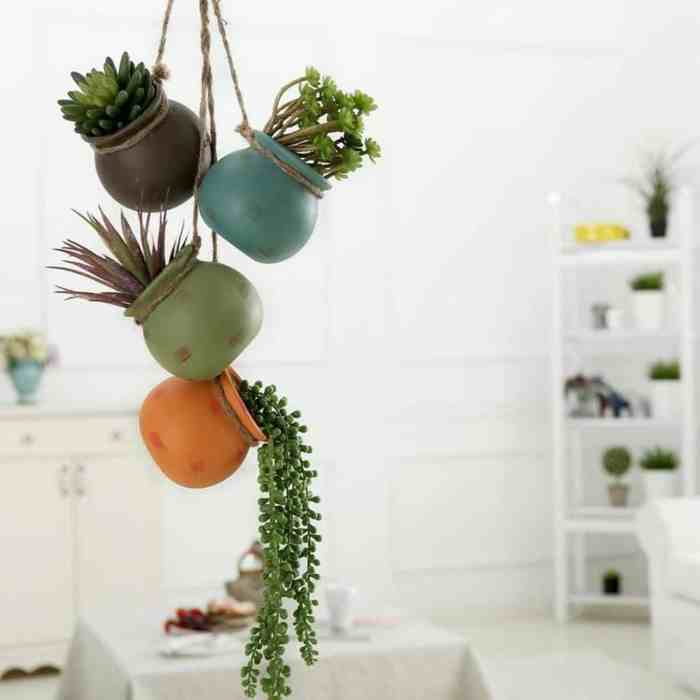
Hanging plants bring a touch of nature and elegance to any indoor space. They can add a pop of color, purify the air, and create a sense of tranquility. Here are some of the most popular indoor plants that thrive in hanging baskets:
Spider Plant
- The spider plant (Chlorophytum comosum) is a popular choice for hanging baskets due to its easy care and ability to tolerate a wide range of conditions.
- It features long, arching leaves with white or yellow stripes.
- The spider plant produces small, white flowers that resemble spiders, hence its name.
- It prefers bright, indirect light and well-drained soil.
Pothos
- The pothos (Epipremnum aureum) is another low-maintenance plant that is perfect for hanging baskets.
- It has heart-shaped leaves that come in a variety of colors, including green, yellow, and white.
- The pothos is tolerant of low light and can even survive in fluorescent lighting.
- It prefers moist, well-drained soil.
English Ivy
- English ivy (Hedera helix) is a trailing plant that is often used in hanging baskets.
- It has glossy, green leaves that can add a touch of elegance to any space.
- English ivy prefers bright, indirect light and well-drained soil.
- It is important to note that English ivy is toxic to pets.
String of Pearls
- The string of pearls (Senecio rowleyanus) is a unique and charming plant that is perfect for hanging baskets.
- It features long, trailing stems with small, round leaves that resemble pearls.
- The string of pearls prefers bright, indirect light and well-drained soil.
- It is important to avoid overwatering this plant.
Ferns
- Ferns are a great choice for hanging baskets because they prefer humid environments.
- They come in a variety of shapes and sizes, so you can find one that will fit any space.
- Ferns prefer bright, indirect light and well-drained soil.
- It is important to mist ferns regularly to keep them hydrated.
Hanging Basket Design Considerations
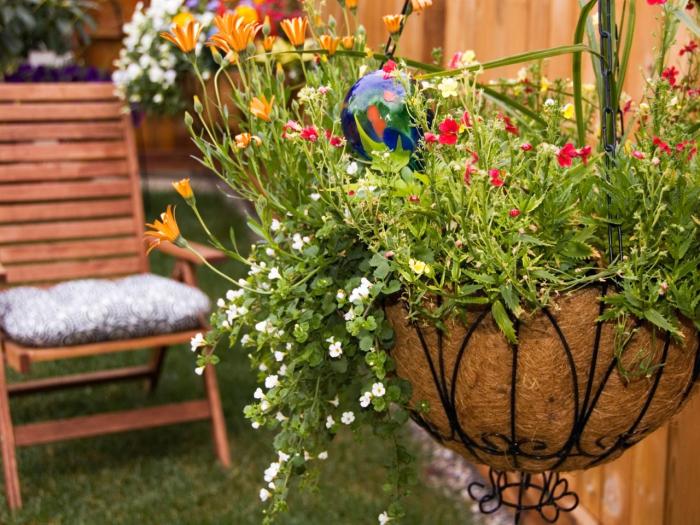
Designing hanging baskets involves careful planning to create visually appealing and thriving plant arrangements. Here are key factors to consider:
Basket Size and Shape, Good indoor plants for hanging baskets
- Choose baskets proportional to the size of the plants and the space available.
- Round or oval baskets provide ample space for root growth, while square or rectangular ones can fit snugly against walls or corners.
- Materials like wire, plastic, or natural fibers offer different aesthetics and durability.
Plant Placement and Spacing
Plan the arrangement of plants to ensure proper light exposure and airflow.
- Tall plants or trailing vines should go in the center or at the back of the basket.
- Shorter plants or those requiring less light can be placed closer to the edges.
- Space plants adequately to prevent overcrowding and allow for future growth.
Color Combinations and Textures
Consider the color and texture of plants to create a visually harmonious display.
- Use contrasting colors for a bold effect or complementary colors for a softer look.
- Combine different textures, such as smooth leaves with frilly ones, to add depth and interest.
- Choose plants with varied foliage shapes and sizes to create a dynamic composition.
Creative Hanging Basket Ideas
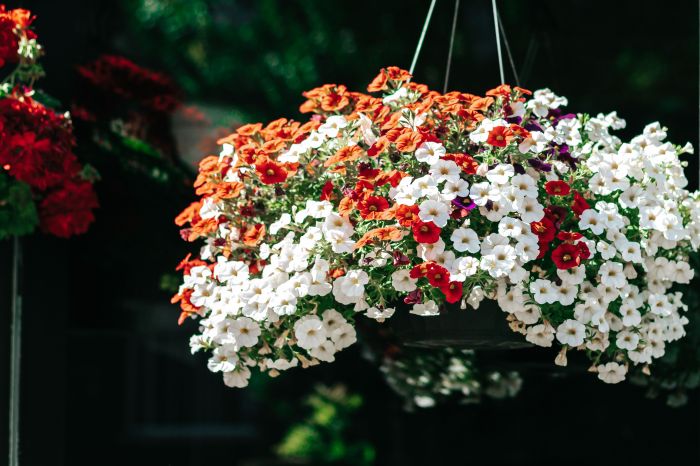
Hanging baskets are a beautiful and practical way to add greenery to your home. They are perfect for small spaces, and they can be used to create a variety of looks, from traditional to modern.
If you’re looking for some creative ideas for hanging baskets, here are a few to get you started:
Macrame Hangers
Macrame is a type of knotting that can be used to create beautiful and intricate designs. Macrame hangers are a popular choice for hanging baskets because they are both stylish and functional. They are also relatively easy to make, so you can create your own custom hangers to match your décor.
Hanging baskets can be a great way to add life to your home, and there are many different types of plants that can be used for this purpose. Some of the best indoor plants for hanging baskets include ferns, ivy, and succulents.
Another popular choice is the goldfish plant ( goldfish plant hanging ), which is known for its beautiful, trailing leaves. Goldfish plants are relatively easy to care for, making them a good choice for beginners. They prefer bright, indirect light and well-draining soil.
With proper care, goldfish plants can thrive in hanging baskets for many years.
Wire Hangers
Wire hangers are another great option for hanging baskets. They are strong and durable, and they can be shaped to create a variety of different looks. You can use wire hangers to create simple, modern hangers, or you can get more creative and create more elaborate designs.
Recycled Items
You can also use recycled items to create unique and stylish hanging baskets. For example, you could use an old tin can, a plastic bottle, or even a piece of wood. Just be sure to clean the item thoroughly before you use it.
Care and Maintenance of Hanging Plants
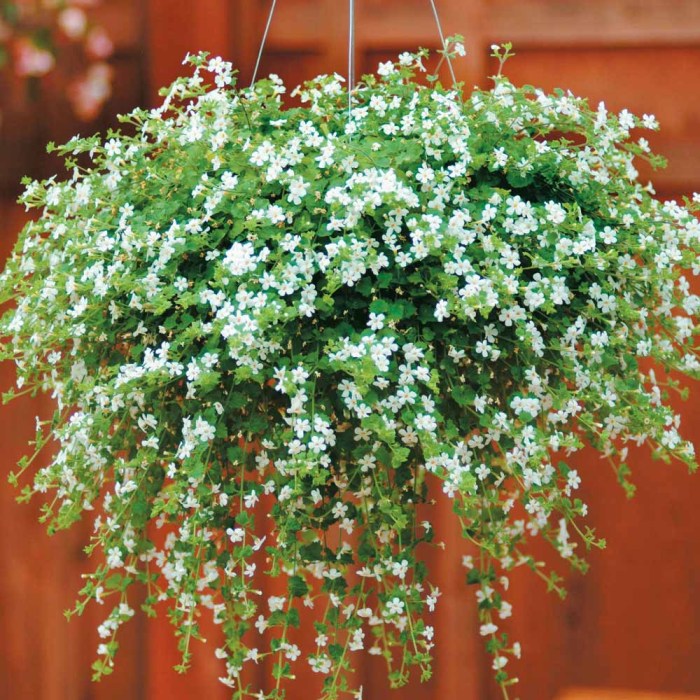
Hanging plants bring a touch of greenery and freshness to indoor spaces, but they require specific care to thrive. Proper watering, fertilization, pruning, and pest and disease management are essential for maintaining the health and beauty of these plants.
Watering Frequency
Hanging plants need regular watering, but the frequency depends on the plant species, pot size, and environmental conditions. Generally, water when the top inch of soil feels dry to the touch. Avoid overwatering, as it can lead to root rot.
Fertilization Needs
Fertilize hanging plants every two to four weeks during the growing season. Use a balanced liquid fertilizer diluted to half strength. Avoid overfertilizing, as it can burn the roots.
Pruning Techniques
Regular pruning encourages bushier growth and prevents leggy stems. Pinch back the tips of new growth to promote branching. Remove any dead or damaged leaves or stems to improve the overall appearance of the plant.
Good indoor plants for hanging baskets can add a touch of greenery and life to any room. If you’re looking for easy indoor hanging plants that can thrive in low light conditions, there are several great options to choose from.
Visit easy indoor hanging plants low light to learn more about these low-maintenance plants that can add a touch of nature to your home.
Pest and Disease Management
Hanging plants are susceptible to pests and diseases, including aphids, mealybugs, and fungal infections. Regularly inspect the plants for signs of infestation or disease. Treat infestations promptly with insecticidal soap or neem oil. For fungal infections, use a fungicide according to the manufacturer’s instructions.
For those seeking verdant decor, good indoor plants for hanging baskets add a touch of elegance and freshness to any space. Trailing house plants, known for their rapid growth and cascading foliage, make excellent choices for these suspended abodes. From the delicate tendrils of the String of Pearls to the vibrant blooms of the Wandering Jew, fast growing trailing house plants bring a dynamic element to hanging baskets, creating a lush and inviting atmosphere.
Troubleshooting Common Problems: Good Indoor Plants For Hanging Baskets
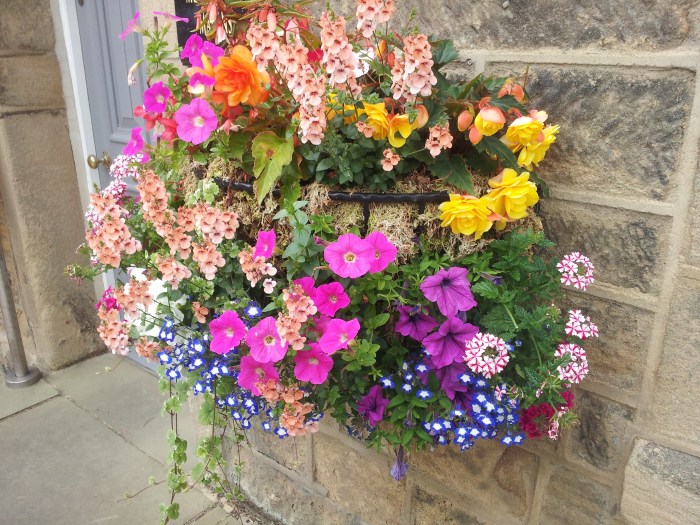
Hanging plants can encounter various issues, but understanding the causes and implementing effective solutions can ensure their health and beauty.
Yellowing Leaves
Yellowing leaves in hanging plants can indicate several problems:-
- Nutrient deficiency:Plants need a balanced supply of nutrients for optimal growth. Yellowing leaves may indicate a lack of nitrogen, potassium, or iron.
- Overwatering:Excess water can suffocate roots and hinder nutrient absorption, leading to yellowing leaves.
- Underwatering:Insufficient watering can cause plants to wilt and lose moisture, resulting in yellowing leaves.
- Chlorosis:Yellowing leaves with green veins may indicate chlorosis, caused by iron deficiency or high pH levels.
Drooping Stems
Drooping stems can be a sign of:-
- Overwatering:Soggy soil can weaken stems, causing them to droop.
- Underwatering:Insufficient water supply can lead to wilting and drooping stems.
- Disease:Root rot or other diseases can damage roots and cause stems to droop.
- Lack of light:Plants need adequate light for photosynthesis and growth; low light levels can result in weak stems.
Pest Infestations
Hanging plants can be susceptible to pests such as:-
- Aphids:These small, soft-bodied insects can suck plant sap, causing yellowing leaves and stunted growth.
- Mealybugs:White, cottony insects that feed on plant juices, leaving behind sticky honeydew.
- Spider mites:Tiny, spider-like creatures that spin webs and feed on plant leaves, causing yellowing and stippling.
Concluding Remarks
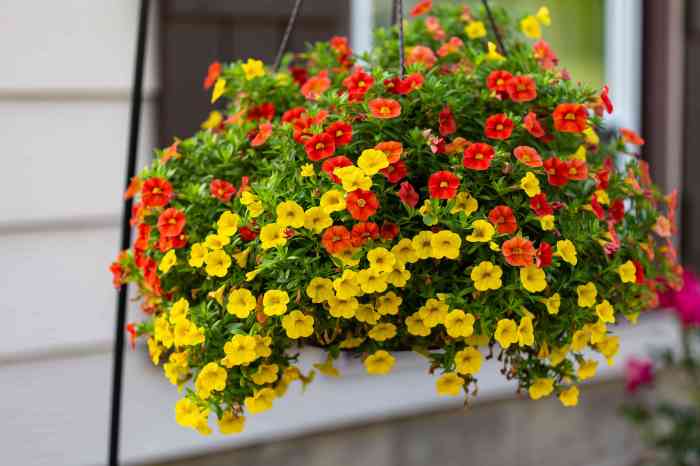
Caring for hanging plants requires attention to watering, fertilization, pruning, and pest management. Troubleshooting common problems like yellowing leaves or drooping stems ensures healthy and thriving plants.
FAQ Resource
What are the most popular indoor hanging plants?
Spider plants, pothos, philodendrons, ferns, and ivy are popular choices due to their ease of care and trailing growth habits.
How often should I water hanging plants?
Watering frequency varies depending on the plant species, but a good rule of thumb is to water when the top inch of soil feels dry to the touch.
What are some creative ideas for hanging baskets?
Consider using macrame hangers, wire frames, or recycled items like old jars or baskets to create unique and stylish displays.